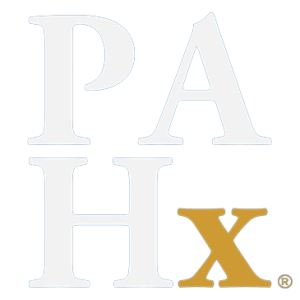1971 to 1980
Establishing a Profession
The structure of a profession rests upon four pillars: A society of practitioners; an association of educational programs training those practitioners; a nationally recognized body charged with accreditation of the programs; and a process of certification of graduates in the public interest.

By the middle of the decade of the 1970s all four of these entities are in place, and functioning with paid executive management. AAPA, established in 1968 by students and alumni of the Duke program, extends membership to graduates from programs around the country, and becomes the legitimate voice for the profession. APAP is formed in 1972 in order to share information among programs regarding curriculum and admission policy. Foundation funding in 1973 permits the establishment of a National Office to manage the affairs of both organizations. The several program models converge as the AMA, together with four medical specialty societies, begins the process of accreditation in 1972. The NBME administers an examination in 1973, followed by the formation, a year later, of the NCCPA, a consortium of societies and agencies, charged with oversight of the certification process. Federal funding, authorized under the 1971 Health Manpower Act, stimulates an explosion of training, tripling the number of programs in a single year, 1972. Begun as a Federal study, a foundation-funded book is published in 1972, tracing the origins of the PA concept, and suggesting policy direction for a new profession. Following four successful conferences, Duke University passes the baton of leadership to the new organizations to create, in 1973, the first nation-wide conference on “New Health Practitioners.” States begin to adopt amendments to their medical practice acts which allow delegation of tasks by physicians to trained assistants. Multiple published studies conclude that PAs function at a level at least comparable to a control group of medical house officers. The AAPA establishes a House of Delegates to govern policy.
The American Medical Association and the American Hospital Association recommend a moratorium on licensure of additional health occupations.
The Comprehensive Health Manpower Training Act (PL92-157) authorizes funding for physician assistant education and deployment.
The American Association of Physician Associates publishes its first official journal, Physician’s Associate.
The AAPA changes their name to the American Association of Physicians’ Associates and updates their articles and bylaws to reflect this. They are also incorporated under this new name and announce that membership will only be allowed to those PAs who are university-trained (Type A PAs).
The Air Force PA Program begins to train physician assistants in July. The PAs are known as “Towner’s Boys” after Lt. General Alonzo Towner, then USAF Surgeon General, who initiated the program’s development.
Cartoonist Dick Moores introduces the general public to physician’s assistants in his comic strip, Gasoline Alley, when Chipper Wallet, a leading character, becomes a PA.
The AMA House of Delegates adopts “Essentials for an Educational Program for the Assistant to the Primary Care Physician.”
The first postgraduate residency program for PAs in surgery is established at the Montefiore Medical Center in Bronx, NY by Marvin Gliedman, MD, Richard Rosen, MD, and Clara Vanderbilt, R-PA.
The American Medical Association forms a Joint Review Committee on Educational Programs for Assistants to the Primary Care Physician (JRC-PA) to evaluate compliance with the “Essentials” adopted by the AMA House of Delegates. Malcolm Peterson, MD, of Johns Hopkins is elected the first Chairman. Lawrence M. Detmer is named Executive Secretary. Sponsoring (Collaborating) Organizations include the American College of Physicians, the American Society of Internal Medicine, the American Academy of Family Physicians, the American Academy of Pediatrics and the Association of American Medical Colleges.
The Association of Physician Assistant Programs (APAP) is established with sixteen charter members to facilitate communication and cooperation among physician assistant educational programs at universities and colleges throughout the United States. Alfred M. Sadler, Jr., MD is elected as the organization’s first president.
The first book written about PAs, The Physician’s Assistant: Today and Tomorrow, by Alfred M. Sadler Jr., MD, Blair L. Sadler, JD, and Ann. A. Bliss, RN, MSW, is published by Yale University Press — based on a “White Paper” that was funded by the Carnegie Corporation, the Commonwealth Fund, the Foundation for the Aid to Crippled Children, the Macy Foundation and the Rockefeller Foundation.
The Bureau of Health Professions Health Resources Administration awards its first contracts to support the development of assistant to primary care physician assistant educational programs.
Nine sponsoring colleges of medicine located throughout the United States establish a National Council of MEDEX Programs to advance the cause of rural health care.
The Army starts their PA training program.
The American Medical Association (AMA) announces the approval of the first PA training programs to be accredited by its Joint Review Committee on Educational Programs for Assistants to the Primary Care Physician (JRC-PA). The programs receiving approval are: Alderson-Broaddus College, Phillipi, WV; Bowman-Gray School of Medicine, Wake Forest University, Winston-Salem, NC; the Brooklyn Hospital, Brooklyn, NY; and the Duke University School of Medicine, Durham, NC. Thirteen other newly created PA programs are listed as receiving Preliminary Approval and Provisional Approval.
Alfred M. Sadler, Jr. MD, and Thomas E. Piemme, MD, receive funding from three foundations in New York — an amount matched by the Robert Wood Johnson Foundation — to establish a National Office in Washington, DC, to serve both AAPA and APAP with a full time staff.
The American Medical Association convenes a meeting of a number of medical professional organizations and government agencies to explore the feasibility of a “Commission” to govern the process of certification of physician assistants.
The American College of Surgeons (ACS) becomes a sponsoring organization of the JRC-PA and publishes “Essentials of an Approved Educational Program for the Surgeon’s Assistant.”
The National Board of Medical Examiners (NBME) administers the first certifying examination for Assistants to the Primary Care Physician to 880 candidates, 10% of whom are graduates of nurse practitioner programs. The exam consists of multiple-choice questions and patient management problems using latent image technology to expose pertinent information.
A highly influential Conference which addressed important policy issues for the emerging field of mid-level practitioners is sponsored by the Macy Foundation of New York. The results were published as a book entitled, Intermediate-Level Health Practitioners, edited by Lippard and Purcell for the Josiah Macy, Jr. Foundation.
Harold Sox, MD, and Richard Tompkins, MD, publish a landmark paper in the New England Journal of Medicine (288:818-24) titled, The Training of Physician’s Assistants: The Use of the Clinical Algorithm System for Patient Care, Audit of Performance and Education.
AAPA becomes a full participating member of the Joint Review Committee on Educational Programs for PAs (JRC-PA). The Committee reviews physician assistant and surgeon assistant programs and makes recommendations to the Committee on Allied Health Education and Accreditation (CAHEA) of the AMA.
The AAPA and APAP joint national office opens in Washington, DC. Donald W Fisher, PhD, serves as the first executive director.
Fourteen national health organizations come together to form the National Commission on Certification of Physician’s Assistants (NCCPA) to provide oversight regarding eligibility and standards for the NBME examination, and to assure state medical boards, employers and the public of the competency of PAs. Thomas E. Piemme, MD, is elected the first President. David L. Glazer is selected as the first Executive Director. A national office is opened the following year in Atlanta, GA.
The NCCPA and the NBME introduce reliable observational checklists into the PA certification examination in order to assess the candidate’s ability to perform a physical examination. It is the first medical professional examination to do so.
The Association of American Medical Colleges (AAMC) holds a two and a half day Institute on Primary Care in Chicago, chaired by Thomas E Piemme, MD, and Steven A. Schroeder, MD. A half-day session on “New Health Practitioners” is chaired by Alfred M. Sadler, Jr. MD. The session helps to incorporate the training of non-physicians into medical education.
Construction of the Trans-Alaska Pipeline from Prudhoe to Valdez begins. Physician assistants are chosen to provide medical services to the more than 10,000 workers employed on the project.
The Robert Wood Johnson Foundation funds the collaborative training of PAs and NPs at several major medical centers.
Komaroff and colleagues publish Protocols for Physician Assistants in the New England Journal of Medicine (290; 307-312).
NCCPA issues its first certificates to PAs who passed the examinations administered by the National Board of Medical Examiners in 1973 and 1974. The clock begins running on reregistration of the certificate every two years, based on hours of continuing medical education, and recertification every six years, based upon reexamination. PAs begin using the designation PA-C to reflect that they have passed the examination and been certified by the NCCPA. State medical boards quickly begin recognizing the certificate as a qualification for practice within the individual states.
APAP receives a three-year grant from the Robert Wood Johnson Foundation that provides continued core staff support for the APAP/AAPA national office and establishes a research division.
A Joint Research and Review Committee of the AAPA/APAP designs and sends the first National PA Survey to 4,583 PAs, of whom 83% report providing primarily primary care services.
AAPA Education and Research Foundation (later renamed the Physician Assistant Foundation) is incorporated to obtain public and private funds to support student scholarships and research about the PA profession.
Rural Health Clinic Services Act (PL95-210) provides Medicare reimbursement for PA and nurse practitioner (NP) services in rural clinics.
Health Practitioner (later named Physician Assistant) journal begins publication and is distributed to PAs as the official publication of the AAPA.
AAPA House of Delegates becomes the policy-making legislative body of the Academy. William Hughes, PA-C, is first Speaker of the House.
The US Air Force begins appointing PAs as commissioned officers, establishing a precedent for the uniformed services.
The NCCPA provides an add-on “Proficiency Examination in Surgery” for PAs. Certification still depends upon passing the “core” PA National Certifying Examination (PANCE).
Number of PA programs accredited: 42
Number of PAs initially certified: 9,431


